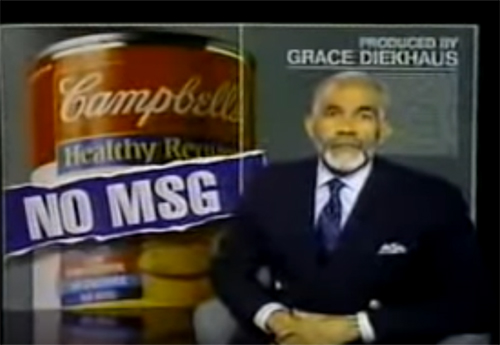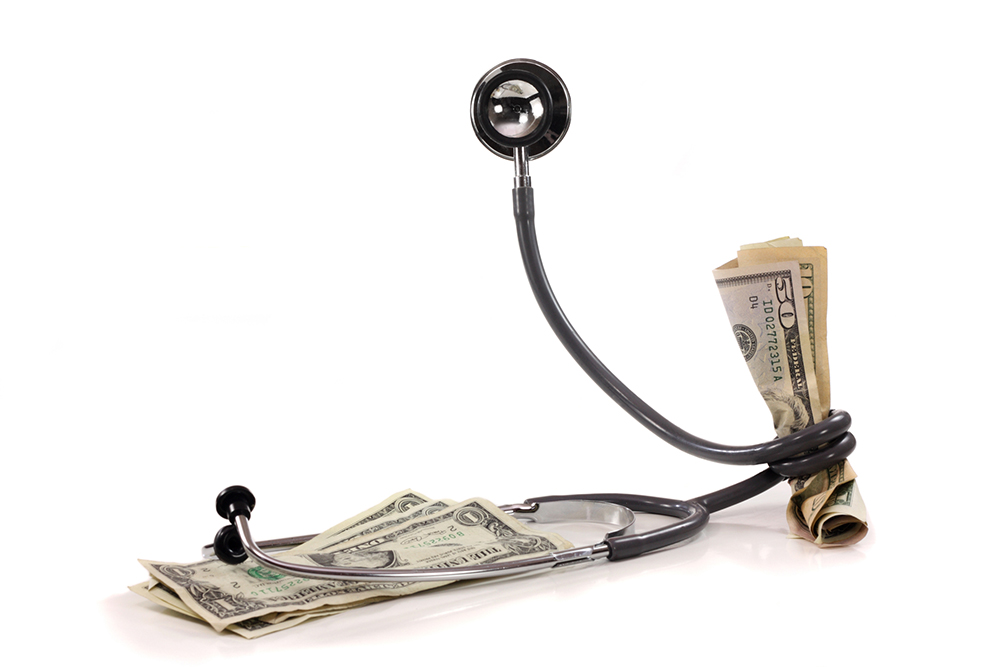October 1991 will always be a month to remember. We had learned that 60 Minutes was considering doing a piece on MSG, and Jack had volunteered to provide them with accurate information about this toxic food additive that would cause him to go into anaphylactic shock.
In early 1990, we had become aware that a segment on MSG was in the works, and over the course of its development, Jack had provided information to Grace Dickhaus and Roz Karson, producers of the 60 Minutes segment.
In March 1991, a producer for the CBS news show called Ajinomoto announcing that they were thinking of doing a segment on Ajinomoto’s product. According to the Wall Street Journal, a group of trade associations launched one of the largest pre-emptive campaigns in public relations history. Specifically, “A crisis-management team specializing in 60 Minutes damage control has been hired to help the industry execute an elaborate game plan to forestall a repeat of the 1989 Alar-on-apples scare.” It was a copy of that crisis-management team’s “July-December 1991 Communications Plan” designed (or possibly simply distributed) by the International Food Information Council (IFIC) that Jack sent to the Wall Street Journal. We had received the “war plan” for IFIC’s assault on 60 Minutes from an anonymous donor on September 4, 1991.
From 1990 till the story aired in 1991, Jack provided information on the toxicity of monosodium glutamate to the 60 Minutes team and later to Bruce Ingersol of the Wall Street Journal – information that they were delighted to confirm. Following are excerpts from Bruce Ingersol’s October 31, 1991 article, “A Case of TV Jitters.”
Adrienne Samuels
Excerpts from A CASE OF TV JITTERS, by Bruce Ingersoll, Wall Street Journal
It has become a business executive’s worst nightmare. The phone rings. A woman on the other end identifies herself as a producer for the CBS News show 60 Minutes. “We are thinking,” she says, “of doing a segment on your product.”
For the food industry, that nightmare began last March. The call went to the Glutamate Association, which represents manufacturers and users of monosodium glutamate. But the shock waves spread quickly. Monosodium glutamate, a flavor enhancer better known as MSG, is used in everything from chicken chow mein to corn chips. A 60 Minutes attack on MSG would be felt throughout the $280 billion-a-year food industry.
No one outside CBS knows when, or even whether, the show will go on the air. No one knows for sure what position it will take or what will be said.
That hasn’t stopped a group of trade associations from launching one of the largest pre-emptive campaigns in public-relations history. They are assuming the worst: A Fearing show’s segment will assail monosodium glutamate, the industry launched a public relations defense.
A crisis-management team specializing in 60 Minutes damage control has been hired to help the industry execute an elaborate game plan. Industry officials have been peppering 60 Minutes producers with letters to try to ensure that their views aren’t ignored. At a minimum, they say, the show should note that the Food and Drug Administration, World Health Organization and European Community all regard MSG as safe. And platoons of public-relations specialists are trying to generate favorable publicity before the show airs.
Indeed, the pre-broadcast ruckus has been so great as to lead the FDA to reconsider its policy on MSG labeling sooner than it would have otherwise. The proposed policy change would blunt any allegation the FDA is letting food companies mask the presence of MSG in food.
Few news enterprises stir greater anxiety among business people than 60 Minutes, CBS’ longest-running, most successful prime-time program. Its impact is resounding, its audience huge. Hewitt and his big-name correspondents have won many Emmy Awards and other honors for distinguished reporting and public service. But they also have attracted plenty of criticism for sometimes taking too strong a stance and practicing ambush journalism.
The food industry has been trying to track every 60 Minutes move. In Los Alamos, N.M., Bradley interviewed an 11-year-old schoolboy who had been the archetypical problem child – hostile, disruptive, extremely hyperactive, according to his parents – before being put on an MSG-free diet. “It was a five-year battle looking for the little boy we once had, and he’s back,” the Los Alamos Monitor quoted his mother as saying, after the 60 Minutes interview. The newspaper said the boy, diagnosed as probably suffering from attention-deficit disorder, told Bradley how much his grades had improved after he stayed away from MSG.
The 60 Minutes team also interviewed Dolores Nick, a 55-year-old suburban Chicago woman, and her 30-year-old daughter, Sandy. Dolores Nick says exposure to MSG leaves her so groggy and “drugged-out” that she has to go to bed. Her daughter, she adds, suffers migraine headaches, sometimes so severe that she requires hospital treatment.
And in Santa Fe, N.M., Bradley interviewed George Schwartz, an anti-MSG physician who wrote a 1988 book called In Bad Taste: The MSG Syndrome. Schwartz, as much as anyone, has made MSG a consumer issue.
The show’s producers also began looking for food-company executives to go on camera. None would agree. That doesn’t surprise the industry’s crisis manager, Nick Nichols, president of Nichols Dezenhall Communications Management Group. The CBS show has “a nightmarish track record on stories involving science and technology,” he says. “The spectacle tends to overwhelm analysis.” What’s more, he adds, 60 Minutes has a history of “rewarding” the viewing public’s extraordinary trust in its reports “by scaring the hell out of them.”
The only scientist to step forward and say what the industry believes – that MSG is not a health threat – was a Washington, D.C., allergist named Fred Atkins, whose academic specialty is adverse reactions to foods. “People said, ‘Why would you do it?’ ” Atkins says. With 10-second sound bites, he concedes, “They can make me look foolish or they can make me look reasonable.”
But Atkins believed that a scientist had to provide an authoritative response. “There may be some individuals with transient mild reactions after ingesting MSG in food,” he says. The common symptoms, sometimes called the Chinese restaurant syndrome, are numbness, tingling or burning in the upper chest, neck and face. “But if the story is that MSG is causing everything from seizures to kids with serious learning disabilities to severe allergic reactions, then viewers are going to be misled,” Atkins asserts.
By early summer, the food industry was fully mobilized to counter the TV show. Its effort was led by the International Food Information Council, a veteran of several food-safety fights, including those over aspartame and food dyes.
At a strategy session at Washington’s Sheraton Carlton Hotel, industry scientists and public relations people viewed a videotape of Schwartz, just to take his measure. The scouting report on the bearded doctor’s TV presence: Very glib. Quite telegenic. Well-rehearsed. Holds up brand-name products.
Impression left on viewers: It’s buyer beware. Next to Schwartz, Atkins seemed like a television tyro.
The industry also prepared a seven-page “communications plan” for blunting the 60 Minutes story. Among other things, it called for gathering intelligence on the assertions of anti-MSG activists who have the ear of 60 Minutes; sounding out other PR tacticians who have taken on networks in similar food-safety controversies; and coordinating efforts to inform opinion leaders.
One objective, according to a copy of the plan obtained by this newspaper, was to create the “best possible climate” of public opinion before the show aired. The International Food Information Council published a reassuring brochure called “What You Should Know About MSG.” In press releases to 2,000 weeklies, the group also trumpeted the news that a European Community scientific panel in June had judged MSG to be safe, even for infants. And thousands of MSG information kits were distributed to food retailers, school-lunch officials and others.
Leaving nothing to chance, the council also tested focus groups to determine the “most effective message points,” and it did a telephone survey to establish a baseline for consumer attitudes about MSG.
After the broadcast, the industry plan called for further focus-group testing and polling, and then striking back with a flurry of press releases to newspapers and video news releases to TV stations. Industry spokesmen would offer to appear on network morning shows.
On Aug. 30, with television’s new season only a fortnight away, the industry went on war footing and started firing shots across the bow. Trade associations sent CBS one letter after another impugning the credibility of Schwartz and other critics and reminding 60 Minutes producer Grace Diekhaus that the FDA puts MSG in the same “generally recognized as safe” category as sugar and salt.
Caught in the middle of this imbroglio was the Food and Drug Administration. The agency briefed Diekhaus on its scientific assessment of MSG and its labeling policies, but then told her that “nothing more would be gained through an on-camera interview.”
In September, 60 Minutes opened its 24th season, intensifying the pressure on the FDA. “Hewitt is pounding on me,” Don McLearn, the agency’s chief spokesman, said at the time. “The problem is, they won’t be fair.” McLearn also complained that the show’s producers wouldn’t sketch out their line of questioning. “That’s ambush journalism,” he said, adding that he wasn’t about to provide “a warm body” that “they can badger.”
Finally, Hewitt laid out the focus of the interview.
“He said the segment will raise three points: Is MSG a problem? Are we working on it? How is MSG labeled?” McLearn says.
Knowing that, FDA officials met late last month to figure out how to handle Ed Bradley’s questions. Commissioner David Kessler discussed his misgivings about the agency’s MSG labeling policy. Currently, food processors have to list MSG as an ingredient only if they add it to products. They don’t have to note its presence in hydrolyzed vegetable protein, a widely used flavor enhancer.
Senior FDA officials ultimately decided to have Deputy Commissioner Michael Taylor sit for an interview with CBS. While being taped, he would break news: The FDA had decided that consumers have a right to know the MSG content of their food, so food processors must declare on labels that hydrolyzed vegetable protein “contains glutamate.” Taylor would emphasize that the policy change wasn’t inspired by health concerns.
The long-awaited interview took place Oct. 1 in the FDA’s Washington office. “We had Mike Taylor pretty well coached,” says McLearn, who had played the role of Bradley in practice. Although the real Bradley “came on strong,” he says, “Mike didn’t get flustered.”
Two days later, 60 Minutes interviewed another food-industry nemesis: John Olney, a professor of psychiatry and neuropathology at Washington University medical school in St. Louis. His position on MSG: “It’s a potential poison, and it’s especially poisonous to the immature nervous system.” He argues that MSG levels in many soups and other foods aren’t safe for infants or children. FDA officials and industry scientists say he’s wrong.
While the industry’s anxiety builds, neither Diekhaus nor Bradley will comment on their roles in the MSG segment. Hewitt expresses great reluctance to discuss a segment before it airs. “I’m telling you a lot of pressure is being brought on us,” he says. “Chances are we will probably air it. If we don’t, it will have nothing to do with Accuracy in Media or the Glutamate Association.”
The Grocery Manufacturers’ Nedelman hopes to pick up a warning before the show airs. The group won’t “wait for them to drop the bomb,” he says. Before that, it intends to contact a dozen important editorial writers and reporters, such as Jane Brody of The New York Times and Daniel Puzo of the Los Angeles Times, and “let them know that 60 Minutes is going to yell fire in a crowded theater,” just as its critics say it did with Alar.
The International Food Information Council is gearing up for video tit for tat with 60 Minutes. If the segment is as alarming as feared, video news releases will be flashed to TV stations nationwide. Overnight letters will go out at once to the news media and others, followed by press releases the following Monday.
Says Nedelman: “It will be like the Democratic response to the president’s address to the nation: Here’s the other side of the story.”
*********************************************
Editorial note. As with all the other promises from the FDA when under pressure to tell the truth about MSG, declaration that manufacturers “…must declare on labels that hydrolyzed vegetable protein “contains glutamate” never happened.
Now, thirty years after the 1991 MSG program was aired, we know things that we didn’t realize before:
- It is only manufactured free glutamate as opposed to glutamate found in whole protein that, when eaten, causes brain damage and a host of reactions ranging from skin rash and fibromyalgia to heart irregularities and seizures.
- Manufactured free glutamate is always accompanied by unwanted by-products of manufacture, called impurities by industry and medical practitioners.
- Glutamate is an excitotoxic amino acid. Monosodium glutamate (MSG) is a man-made product composed of L-glutamic acid (L-glutamate), sodium, moisture, D-glutamic acid (D-glutamate), pyroglutamic acid, and other impurities (unwanted and unavoidable by-products of the manufacture of L-glutamate). MSG is manufactured in plants throughout the world. In the United States, MSG is produced in Ajinomoto’s factory in Eddyville, Iowa. Its principal ingredient is its excitotoxic, brain damaging, L-glutamate.
L-glutamate is the L enantiomer of glutamic acid (glutamate), an acidic amino acid which when present in protein or released from protein in a regulated fashion (through routine digestion) is vital for normal body function. It is the principal neurotransmitter in humans, carrying nerve impulses from glutamate stimuli to glutamate receptors throughout the body. Yet, when present outside of protein in amounts that exceed what the healthy human body was designed to accommodate (which can vary widely from person to person), glutamate becomes an excitotoxic neurotransmitter, firing repeatedly, damaging targeted glutamate-receptors and/or causing neuronal and non-neuronal death by over exciting those glutamate receptors until their host cells die. - The research referred to by glutamate industry agents as demonstrating MSG’s safety is flawed to the point of being fraudulent. The most easily understood of their devious experimental methods has been the use of excitotoxic amino acids deceitfully called “placebos” used in double-blind studies.
- Prior to 1957 MSG was produced by extracting glutamate from a protein source. This was a slow and costly method. In 1957, Ajinomoto began producing MSG using bacterial fermentation, whereby carefully chosen genetically modified bacteria fed on a nourishing medium, excreted glutamate through their cell walls. With that change, production of MSG skyrocketed, making it possible for a consumer to ingest sufficient (excessive) amounts of this manufactured glutamate during the course of a day to cause the glutamate to become excitotoxic.
It was shortly after this change in production that the first published reports of reactions to MSG appeared in the New England Journal of Medicine, the first report of MSG-induced brain damage appeared in the journal Science, obesity rose to epidemic proportions, and the incidence of infertility escalated. MSG-induced brain damage leads to both obesity and infertility.
- The so-called scientific bodies that have attested to the safety of MSG have done no research of their own. only reviewing the research of others. Neither did any of them search the literature for relevant research. The studies that they reviewed were given to them by the FDA (whose work suffered from serious conflicts of interest) and/or by agents of the glutamate industry.
If you have questions or comments, we’d love to hear from you. If you have hints for others on how to avoid exposure to MfG, send them along, too, and we’ll put them up on Facebook. Or you can reach us at questionsaboutmsg@gmail.com and follow us on Twitter @truthlabeling.





